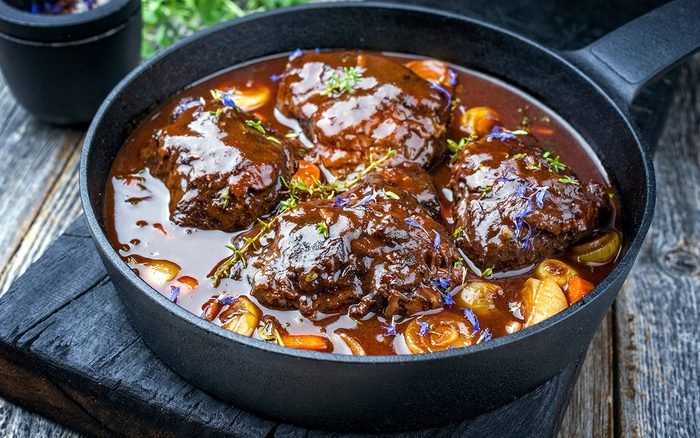For a great Sunday dinner, roasting makes tender, pull-apart meats (and vegetables). This method is great for short ribs with red wine, chicken tenders with mushrooms, whole cauliflower in tomato sauce, and chicken thighs in vegetable stock.
You can learn the basics of braise and make the slow-cooked dish you desire with just a few techniques.
What is Braising?
Harold McGee’s “On Food and Cooking ” explains that the traditional French word “braise” refers to “a closed pan sitting on top or covered with charcoal.” Braising is a more common term nowadays. It involves pan-searing meat (a dry-heat cook) and then simmering the meat in a liquid at a gentle, low heat. The result is a meat that is both tender and flavorful due to the aromatic liquid.
Roasting is different from braising in that the meats are cooked in liquid. The meat is often browned on the stovetop before being placed in the oven. You can also cook it on the stovetop over low heat. The Maillard reaction caramelizes sugars in meat or vegetables through searing, which adds rich flavor.
Which type of meat or vegetable is best for braising?
Braising takes several hours because it is done at low heat. This is a great method for cheaper meats that have a lot more connective tissue. The longer time allows collagen to dissolve into gelatin, which helps pull apart the meat fibers.
We recommend beef short ribs (thick cut), beef chuck roast (thick-cut), pork shoulder, chicken legs or thighs, lamb shank, lamb shoulder and turkey legs. Veal shanks are also recommended (Osso Bucco).
A braise can be used with most vegetables; I love onions, artichokes and green beans. Braised vegetables are tender and sweet but not mushy. Even though vegetables take less time than meats to prepare, larger vegetables such as cauliflower can still take over an hour.
What is the best temperature for breezing?
Braising is both dry and wet heat, so there are several temperatures to be aware of.
The meat is first browned on all sides in a pan over medium heat. The meat is then removed from the pan, and any aromatics are sautéed in the remaining fat. The meat is then added to the liquid and simmered on low heat, either in the oven or stove. Braises in the oven can range from 250°F to 325°F.
How can I make my braise more flavorful?
There are several ways to add flavor to the dish.
- Dry brine meat: When cooking with meat, ensure that you season it on all sides before pan-searing. To soak up the seasoning, you can apply a dry brine to the meat a few hours to a full day ahead.
- Add aromatics Traditional aromatics add sweetness and earthiness. You can also experiment with bell peppers and fennel or chilli peppers.
- Add spices to the braising liquid: Red chilli flakes, black peppercorns and bay leaves are good options for adding heat and earthiness. To simmer the braising liquid, I might add dried herbs like bay leaves, oregano and fresh herbs like basil or parsley.
- Select your favorite braising liquor: There are many choices for braising liquids, including white wine, red wine and meat or vegetable stock. Coca-cola has been used as a braising liquid. A sweeter braising liquid will caramelize and reduce in volume. Combining different options is possible, like red wine and beef broth.
What special equipment do I need?
A braiser or heavy-bottomed saucepan is the only piece of equipment that you will need. Dutch ovens are great, but you can also use a large, heavy-bottomed pot made of stainless steel. You should ensure that the pot you use for baking is oven-safe
How to braise meat and vegetables (Step-by-Step Instructions).
- Grill the meat (optional). Heat a braiser on medium heat. Add a tablespoon of oil. Allow the pan to heat up, add the meat or vegetables to the pan and cook until golden brown. The initial sear on each side should take no less than 5 minutes. To ensure that the meat or vegetable is properly caramelized, you can adjust the heat as necessary. Set the vegetable or meat off the heat and place in a bowl.
- Use aromatics for cooking: If the bottom of the pan gets too hot, turn off the heat and wipe it with a damp cloth. Keep the fat in your pan to retain the brown bits and delicious frond. Add your aromatics (onion, celery, garlic, etc.) Add any dried, tough herbs or spices (bay leaves and cinnamon sticks). Turn heat to medium until aromatics become translucent and soft, approximately 8-10 minutes.
- Add pastes: Add any paste such as tomato, anchovy, or Calabrian chilli. Mix well and let cook on medium heat for 3-4 minutes.
- Add wine (optional). Increase heat to medium-high, then add your wine. Bring to a boil and let the wine simmer for several minutes until it reduces.
- Add your braising fluid and herbs. Pour in any other braising liquors or herbs that you would like to cook the meat in. Season the meat with salt and pepper.
- Put the vegetable or meat back in: Put the pan-seared vegetable or meat back into the pan, and gently place in the liquid. You want enough liquid to submerge meats fully. You can either submerge the vegetable halfway or completely. You can submerge halfway to create a reduced sauce on the bottom. Then roast or crisp the vegetables.
- Let simmer. Let the vegetable or meat simmer on low heat covered for 30 to 60 minutes depending on the cut. The stovetop or oven can be used to simmer the meat. Once done, the meat should be soft and easy to pierce with a knife. Vegetables should be easily cut with a knife.
- You can either leave the meat as it is or removes some fat using a spoon. It is often easier to remove fat from the liquid once it has chilled in the refrigerator. You can prepare the braise the day before and let it chill in the refrigerator before removing the fat.
- Add more sauce: If you want to thicken the sauce, take out the meat or vegetables and cook it down until it reaches desired consistency. Sometimes I blend the liquid until it becomes a thick, velvety sauce.






More Stories
Cooking Advice From Mom
How to Host a Mimosa Bar
Know Your Spices: Galangal